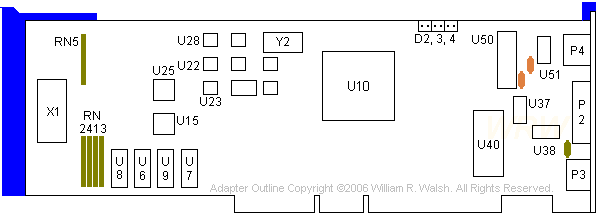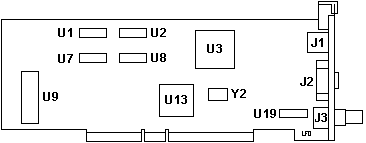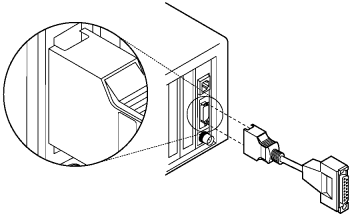|
"LEGENDS" card Linux Driver for the IBM LAN Adapter/A for Ethernet EMTLAN.ZIP IBM LAN Adapter/A Option Disk v2.2 (9-15-95) (Thanks to Dan Hamilton) ETHER32a.ZIP IBM LAN Adapter/A Option Disk v1.0 (2-25-93) laninst.pdf Installation and Testing instructions for the LAN Adapter /A. (IBM PCBBS) LAN Adapter/A for Ethernet-Installation and Testing e2ra2000.boo Technical Reference Ethernet Adapter Interface bk8r0000.boo Alfred Arnolds LAN Adapter Shootout results. LAN /A is pretty good... LAN Adapter/A(Old)
LAN Adapter/A (Old) FRU 48G7172 (same as newer card!) 
D2-4 I read the SONIC-T datasheet and traced the leads to find out the diode functions. It was easy since the traces are straightforward - they stay on the top layer of the board and go right to the matching pins on the IC. P2 - Apple Attachment Unit Interface (AAUI) Connector (no, it's not a "dorky mini-AUI" or "IBM bizarro C14") You can see some AAUI "breakouts" here. A pinout is available here. Since this adapter already has RJ45 and coaxial connectors, my guess is that the AAUI connector is provided for attachment to "thicknet" coaxial networks. You could also use it to bypass a failed component on the adapter. Thoughts & Experiences
I found this card (and continue to use it) in a 9585-0X6. This card and the host computer were both filthy and kept somewhere very damp.As a testament to IBM's ability to build quality hardware, the card has (sometimes heavy) rust in places but it continues to work excellently. If there was one major "strike" against this adapter, it would be the "requirement" to have a network cable connected to it at startup. The LAN/A performs a self test and checks for the presence of a network cable. If it doesn't find one, then it will complain and may even cause the elusive "265" POST error to surface on some machines and circumstances. Rick Ekblaw suggested this to keep the LAN/A from complaining: (see
Soft
Error 265)
(WRW. You'd probably have to build one. I saw nobody selling Ethernet wrap plugs other than the IBM AUI wrap plug, which I already have.) NOTICE:
LAN Adapter /A (new) 48G7172 (also FRU 10H4633) 
Mini AUI to AUI Cable P/N 59G9004 
Sorry, William, that's what IBM calls it. Not AAUI....
Soft Error 265 Rick Ekblaw rears up from the mists at IBM and utters: The PS/2 error code 265 (or 00026500) has been a bit of "myth" to me -- I'd heard of people getting it, but had never seen one myself until yesterday. I was working on reviving a PC Server 500 with the P/390
card set (a worthy endeavor, I assure you). This PC Server 500 has
a 2-channel SCSI Fast/Wide RAID adapter (Passplay), a P/390 processor card
with daughter card (additional S/390 RAM), a "Huron" S/370 Channel Adapter,
The LAN/A was configured for twisted pair (RJ45 connector), but I didn't have it plugged into the network, and the LAN/A POST was throwing up a PR011 error on the screen (Transmission loopback failure). No other error codes were being posted, and the information panel was not showing an error code, either. But just when you expected the machine to boot, it prompted for the Reference Diskette. OK, put in the Reference Diskette, press F1, and it said that the system posted error 265, run Diagnostics to isolate the error. Thinking that the 265 was some sort of "soft" error related
to the PR011, I plugged the LAN/A into a hub so that the LAN/A POST ran
clean. Sure enough, the machine would now boot into OS/2 Warp 3 without
complaint, and I could IPL OS/390 (*that* took a while, the 390
AdapterId FFE0 IBM LAN Adapter/A for Ethernet Adapter Base I/O Address
Adapter Interrupt Request Level
Network Media Connection
Adapter BIOS-ROM / RAM Location
|